- September 7, 2023
- Posted by: Love Uganda Love Uganda
- Category: Blog
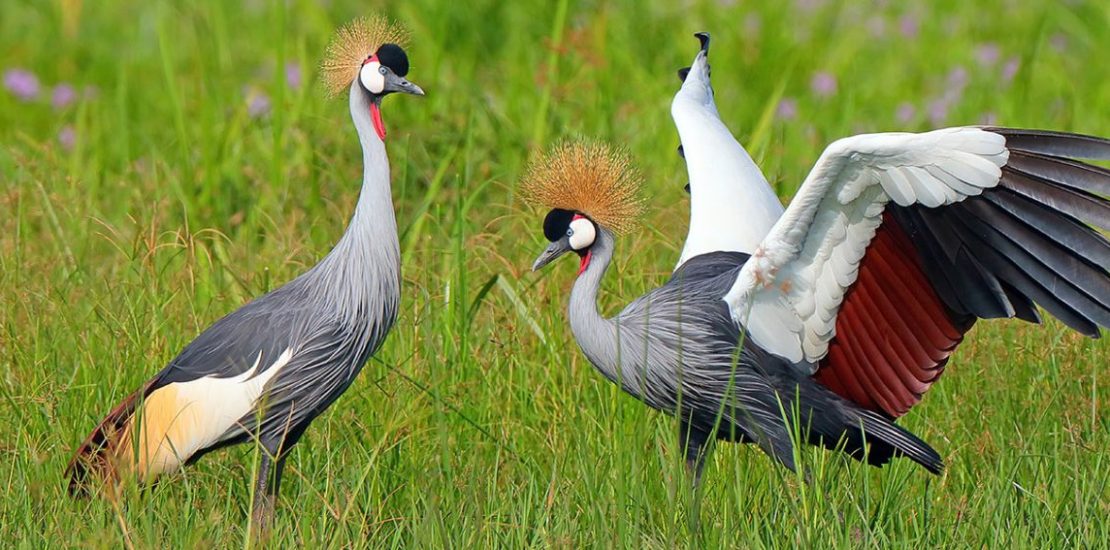
The amazing Uganda birding tours – Top birding destinations in Uganda
Uganda is a fantastic destination for birdwatchers, with over 1000 bird species recorded. When planning a birding trip to Uganda, it is important to choose a reputable tour company that specializes in birding and has experienced birding guides. It is also important to respect the birds and their habitats. Avoid disturbing nesting areas or interfering with the birds’ natural behavior. Keep a safe distance from the birds. Do not use flash photography. By following responsible and sustainable tourism practices, you can help protect Uganda’s rich birdlife for future generations to enjoy.
Here are some of the top birding destinations in Uganda:
Mabamba Swamp: This wetland on the shores of Lake Victoria is known for its population of shoebill storks. It is also home other water birds such as herons, egrets, and kingfishers.
Queen Elizabeth National Park: This Park is one of the best birding destinations in Uganda. The park has over 600 bird species recorded. Look for species such as African skimmer, papyrus gonolek, and African finfoot.
Bwindi Impenetrable Forest: This UNESCO World Heritage Site is home to over 350 bird species. These include several Albertine Rift endemics such as the African green broadbill, Shelley’s Crimsonwing, and yellow-eyed black flycatcher.
Kibale Forest National Park: This Park is known for its primate population, but it’s also a great birding destination. Look for species such as African pitta, black bee-eater, and green-breasted pitta.
Budongo Forest Reserve: This forest reserve is located in the northwestern part of Uganda. It is also home to over 360 bird species. Look for species such as chocolate-backed kingfisher, African paradise flycatcher, and red-tailed bristle bill.
Murchison Falls National Park: This is Uganda’s largest national park and a great birding destination. Look for species such as Goliath heron, Abyssinian ground hornbill, and shoebill stork.
Birding in Mabamba Swamp
Mabamba Swamp is a wetland located on the shores of Lake Victoria, about 50 kilometers west of Kampala. It is one of the best places in Uganda to see the elusive shoebill stork. This is one of the most sought-after birds by birdwatchers. Mabamba Swamp is a unique and incredible birding destination in Uganda. It is a must-visit for birdwatchers. With the help of a knowledgeable guide and a bit of luck, you can spot the iconic shoebill stork and other fascinating bird species in their natural habitat.
Here are some tips for birding in Mabamba Swamp
Hire a local guide
It is recommended to hire a local guide who is familiar with the area. You can find guides at the Mabamba Bay Information Centre or through tour companies that offer birding trips to the swamp such as the Love Uganda Safaris and Tours.
Take a canoe ride
The best way to see the shoebill stork is by taking a canoe ride through the swamp. The guides will paddle the canoe while you keep an eye out for the birds. The canoe ride can take anywhere from 2-4 hours, depending on the water levels. Retreat to any of the nearby beaches and enjoy a spectacular Uganda birding safari experience.
Timing
The best time to see the shoebill stork is early in the morning or late in the afternoon when they are most active. It is recommended to arrive at the swamp by 7:00 am or stay till 5:00 pm.
Other bird species
Mabamba Swamp is also home to other bird species such as African jacana, Malachite kingfisher, pied kingfisher, Swamp flycatcher, and several species of weavers.
Bring appropriate gear
Bring appropriate gear such as binoculars, a camera with a telephoto lens, insect repellent, and sunscreen. Wear comfortable clothing and shoes that can get wet. It is also recommended to bring a hat and a rain jacket in case of rain.
Respect the birds and their habitat
While birding in Mabamba Swamp, it is important to respect the birds and their habitat. Do not disturb nesting areas or interfere with the birds’ natural behavior. Keep a safe distance from the birds and do not use flash photography.
Conservation fee
A conservation fee is required to enter the swamp, and it helps to support the local community and conservation efforts in the area. Make sure to pay the fee at the Mabamba Bay Information Centre before entering the swamp.
Birding in Semuliki national park
Semuliki National Park is a birding hotspot in western Uganda. It is located at the border with the Democratic Republic of Congo. The park is home to over 400 bird species. They include several Albertine Rift endemics and West African species that are not found elsewhere in East Africa.
What are the best birding trails in Semuliki National Park?
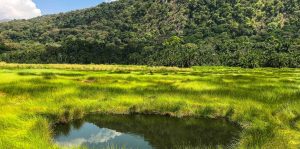
Semuliki National Park is a birding hotspot in western Uganda, with several birding trails that offer great opportunities to spot a variety of bird species. Here are some of the best birding trails in Semuliki National Park:
Kirumia Trail: This is the most popular birding trail in Semuliki National Park, and it takes you through the heart of the forest. The trail is about 13 kilometers long and can take up to 8 hours to complete. Along the way, you can spot several bird species such as the Congo serpent eagle, hornbills, turacos, and cuckoos.
Sempaya Nature Trail: This trail is shorter than the Kirumia Trail, but it offers great birding opportunities. The trail takes you to the hot springs. Here you can spot several bird species such as the Rwenzori turaco, black-and-white casqued hornbill, and palm-nut vulture.
Red Monkey Trail: This trail is named after the red-tailed monkey, which is commonly seen in the area. The trail takes you through a forested area where you can spot several bird species such as the yellow-throated cuckoo, blue-breasted kingfisher, and African pied hornbill.
Ntandi Trail: This trail is located near the park headquarters and takes you through a forested area. Along the way, you can spot several bird species such as the African dwarf kingfisher, great blue turaco, and white-thighed hornbill.
Mungilo Trail: This trail takes you through a grassland area where you can spot several bird species such as the Abyssinian ground hornbill, black-billed barbet, and Senegal coucal.
Semuliki River Trail: This trail follows the Semuliki River and offers great birding opportunities. You can spot several bird species such as the African finfoot, African pygmy kingfisher, and Ross’s turaco.
Birding in Lake Mburo national park
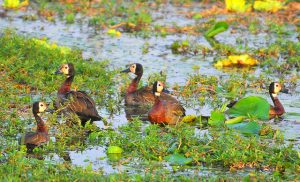
Lake Mburo National Park is a small but beautiful park located in western Uganda, between Masaka and Mbarara. The park is home to over 350 bird species, and it is a great destination for bird watching.
Birding trails in Lake Mburo national park
Lake Mburo National Park offers several birding trails, each offering different bird species and habitats. Here are some of the best birding trails in Lake Mburo National Park:
Warukiri Trail: This trail is located on the eastern side of the park and is a great place to spot several bird species such as the African grey hornbill, swamp flycatcher, and yellow-breasted apalis. It is a relatively short trail and takes about 1-2 hours to complete.
Rubanga Forest Trail: This trail is located in the center of the park and takes you through a beautiful forested area. Along the way, you can spot several bird species such as the narina trogon, green pigeon, and African emerald cuckoo. The trail is about 4 kilometers long and can take up to 3 hours to complete.
Lake Shoreline Trail: This trail follows the shoreline of Lake Mburo and offers great opportunities to see water birds such as the African fish eagle, pied kingfisher, and malachite kingfisher. You can also spot several other bird species such as the African jacana, African wattled lapwing, and black-headed weaver.
Kazuma Trail: This trail is located on the western side of the park and takes you through grassland and woodland areas. Along the way, you can spot several bird species such as the brown-chested lapwing, crowned crane, and black-bellied bustard. The trail is about 5 kilometers long and can take up to 4 hours to complete.
Ruroko Track: This trail is located on the northern side of the park and takes you through woodland and savannah habitats. You can spot several bird species such as the African harrier hawk, red-headed lovebird, and African scops owl. The trail is about 6 kilometers long and can take up to 5 hours to complete.
Birding trails in Queen Elizabeth national park
Queen Elizabeth National Park is one of the best birding destinations in Uganda, with over 600 bird species recorded. The park has several birding trails, each offering different bird species and habitats. Here are some of the best birding trails in Queen Elizabeth National Park:
Mweya Peninsula: This is one of the most popular birding areas in the park, with several habitats such as woodland, savannah, and wetlands. Along the way, you can spot several bird species such as the African fish eagle, martial eagle, and African skimmer.
Kasenyi Plains: This area offers great opportunities to see grassland bird species such as the Rufous-naped lark, black-bellied bustard, and Temminck’s courser.
Ishasha Sector: This area is known for its tree-climbing lions, but it is also a great place to spot bird species such as the broad-billed roller, African grey hornbill, and red-billed hornbill.
Maramagambo Forest: This forested area is home to several bird species such as the African green broadbill, white-napped pigeon, and blue-breasted kingfisher. You can also spot several monkey species such as the black-and-white colobus and red-tailed monkey.
Kyambura Gorge: This area offers great opportunities to see forest bird species such as the African pygmy kingfisher, black bee-eater, and blue-headed sunbird. You can also spot several primate species such as the chimpanzee and black-and-white colobus.
Kazinga Channel: A boat ride on the Kazinga Channel is a great way to see water birds such as the African skimmer, pink-backed pelican, and saddle-billed stork.
Katwe Salt Lake: This area is known for its salt mining activities, but it is also a great place to spot bird species such as the flamingo, African jacana, and black-winged stilt.
Birding in Lake Munyanyange
Lake Munyanyange is a small lake located in southwestern Uganda, near the border with Rwanda. The lake is a great destination for bird watching, with several bird species found in the area.
Lake Munyanyange may be a small lake, but it is a hidden gem for birdwatchers looking for a peaceful and unique birding experience in Uganda. With the help of a knowledgeable guide and a bit of luck, you can spot some of the most beautiful and interesting bird species in their natural habitat.
Birding trails in Lake Bunyonyi
Lake Bunyonyi is a beautiful lake located in southwestern Uganda. It is known for its stunning scenery and rich birdlife. The lake and its surrounding hills and islands offer several birding trails, each offering different bird species and habitats.
Here are some of the best birding trails in Lake Bunyonyi:
Habuharo Island: This Island is one of the most popular birding spots in Lake Bunyonyi. It has several bird species such as the African fish eagle, pied kingfisher, and malachite kingfisher. The island is accessible by boat, and you can explore it on foot with your guide.
Bwama Island: This Island is known for its dense forest. And offers great opportunities to see forest bird species such as the Rwenzori turaco, black and white casqued hornbill, and African emerald cuckoo.
Kyahugye Island: This Island is home to several bird species such as the African pygmy kingfisher, grey-crowned crane, and African marsh harrier. You can explore the island on foot with your guide.
Mukoni Hill: This hill offers great views of the lake and its surrounding areas, and it’s also a great place to spot bird species such as the long-crested eagle, African hill babbler, and yellow-bellied waxbill.
Lake Shoreline Trail: This trail follows the shoreline of Lake Bunyonyi and offers great opportunities to see water birds such as the African jacana, African black duck, and white-winged tern.
Bushara Island: This Island is located on the eastern side of the lake and offers great opportunities to see forest bird species such as the red-headed bluebill, yellow-bellied wattle-eye, and black-throated apalis.
Punishment Island: This small island was historically used as a place where unmarried pregnant girls were abandoned to die. Today, it is a birding hotspot where you can spot several bird species such as the grey crowned crane, African fish eagle, and black kite.
Birding trails in Bigodi Wetland
Bigodi Wetland Sanctuary is a beautiful and unique wetland located in southwestern Uganda, near the town of Fort Portal. The wetland is home to over 200 bird species, making it a great destination for bird watching.
Here are some of the best birding trails in Bigodi Wetland Sanctuary:
Bigodi Trail: This is the main trail in the sanctuary and takes you through the wetland and surrounding forested areas. Along the way, you can spot several bird species such as the great blue turaco, African grey parrot, and yellow-billed barbet.
Magombe Swamp Trail: This trail takes you through a dense swampy area. This is a great place to spot water birds such as the African jacana, pied kingfisher, and African pygmy goose.
Kibale Forest Trail: This trail takes you through the nearby Kibale Forest, which is home to several bird species such as the black bee-eater, African pitta, and African green broadbill.
Bigodi Village Trail: This trail takes you through the nearby village of Bigodi. Here you can spot several bird species such as the black-and-white shrike-flycatcher, common bulbul, and African paradise flycatcher.
Community Trail: This trail takes you through the surrounding community lands, which is a great place to spot bird species such as the African harrier hawk, African hoopoe, and yellow-rumped tinker bird.
Birding trails in Murchison falls national park
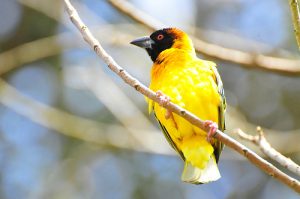
Murchison Falls National Park is one of the largest and most popular national parks in Uganda. It is located in the northern region of the country. The park is home to over 450 bird species, making it a great destination for bird watching.
Here are some of the best birding trails in Murchison Falls National Park:
Delta Trail: This trail follows the Nile River delta and offers great opportunities to see water birds such as the African fish eagle, Goliath heron, and black-headed lapwing.
Buligi Game Tracks: These tracks offer great opportunities to see grassland bird species such as the Abyssinian ground hornbill, secretary bird, and black-bellied bustard.
Rabongo Forest Trail: This forested area is home to several bird species such as the yellow-footed flycatcher, western nicator, and yellow-spotted barbet.
Paraa Road: This road follows the Nile River and offers great opportunities to see bird species such as the saddle-billed stork, grey-headed kingfisher, and Senegal thick-knee.
Chobe Escarpment Trail: This trail takes you through a hilly area and offers great opportunities to see bird species such as the African green pigeon, white-crested helmet shrike, and brown snake eagle.
Kaniyo Pabidi Trail: This trail takes you through a forested area and offers great opportunities to see bird species such as the chocolate-backed kingfisher, African pied hornbill, and African dwarf kingfisher.
Nile Delta Cruise: A boat cruise on the Nile River delta is a great way to see water birds such as the shoebill stork, African jacana, and African skimmer.
Birding trails in Bwindi impenetrable national park
Bwindi Impenetrable National Park is a UNESCO World Heritage Site located in southwestern Uganda. The park is home to over 350 bird species, including several Albertine Rift endemics, making it a great destination for bird watching. Below are some of the best birding trails in Bwindi Impenetrable National Park:
Buhoma Waterfall Trail: This trail takes you to a beautiful waterfall and offers great opportunities to see bird species such as the African green broadbill, western green tinker bird, and yellow-billed barbet.
Mubwindi Swamp Trail: This trail takes you through a swampy area and offers great opportunities to see bird species such as the Grauer’s swamp warbler, African green broadbill, and red-throated alethe.
Bamboo Trail: This trail takes you through a bamboo forest and offers great opportunities to see bird species such as the African green broadbill, mountain masked apalis, and yellow-streaked greenbul.
Ruhija Trail: This trail takes you through a forested area and offers great opportunities to see bird species such as the African green broadbill, western bronze-napped pigeon, and African hill babbler.
Ivy River Trail: This trail follows the Ivy River and offers great opportunities to see bird species such as the white-bellied robin-chat, red-faced woodland warbler, and yellow-eyed black flycatcher.
Buhoma- Nkuringo Trail: This trail connects the Buhoma and Nkuringo areas of the park and offers great opportunities to see bird species such as the African green broadbill, grey cuckoo-shrike, and dusky Crimsonwing.
Kashasha River Trail: This trail follows the Kashasha River and offers great opportunities to see bird species such as the purple-breasted sunbird, cinnamon-chested bee-eater, and black-billed weaver.
Birding areas near Kampala city
Kampala is the capital city of Uganda and is surrounded by several birding areas that are easily accessible for day trips. Here are some of the best birding areas near Kampala city:
Mabamba Bay Wetland: This wetland is located on the shores of Lake Victoria, about 50 km southwest of Kampala. It is one of the best places in Uganda to see the shoebill stork, as well as other water birds such as the African jacana, African pygmy goose, and white-winged tern.
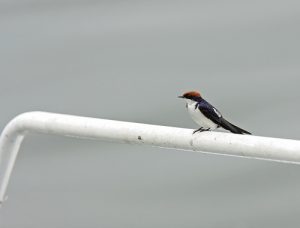
Entebbe Botanical Gardens: These gardens are located in Entebbe, about 40 km south of Kampala. The gardens are home to several bird species such as the African pied hornbill, Ross’s turaco, and yellow-billed kite.
Mpanga Forest Reserve: This forested area is located about 37 km west of Kampala and is home to several bird species such as the blue-breasted kingfisher, great blue turaco, and grey-throated barbet.
Nabajjuzi Wetland: This wetland is located about 35 km east of Kampala and offers great opportunities to see water birds such as the grey crowned crane, African jacana, and African pygmy goose.
Kasenge Forest Reserve: This forested area is located about 30 km southeast of Kampala and is home to several bird species such as the African broadbill, green-throated sunbird, and black-and-white-casqued hornbill.
Lake Victoria: The shores of Lake Victoria, which is the largest lake in Africa, offer great opportunities to see water birds such as the African fish eagle, pied kingfisher, and malachite kingfisher.
Kajjansi Fish Farm: This fish farm is located about 20 km south of Kampala and offers great opportunities to see bird species such as the African fish eagle, black kite, and African pied wagtail.
What is the necessary equipment for a birding safari to Uganda?
When going on a birding safari to Uganda, it is important to bring the necessary equipment to ensure a comfortable and successful birding experience. Here are some of the necessary equipment to bring on a birding safari to Uganda:
Binoculars
A good pair of binoculars is essential for birding in Uganda. Look for binoculars with a magnification of 8x to 10x and an objective lens of at least 42mm. A waterproof and fog-proof design is also recommended.
Camera
A camera with a telephoto lens is essential for capturing memorable photos of the birds you spot on your safari. Make sure to bring extra batteries and memory cards.
Field guide
A field guide to the birds of Uganda is essential for identifying the bird species you spot on your safari. Look for a comprehensive guide with clear illustrations, range maps, and descriptions of behavior and vocalizations.
Clothing
Pack comfortable and lightweight clothing suitable for the tropical climate of Uganda. Long-sleeved shirts and pants are recommended to protect against insects and the sun. A rain jacket and hat are also recommended.
Footwear
Bring comfortable and sturdy hiking boots or shoes suitable for walking on uneven terrain.
Insect repellent
Mosquitoes and other biting insects are common in Uganda. So bring a good quality insect repellent with at least 20% DEET.
Sunscreen
The sun can be strong in Uganda, so bring a high-SPF sunscreen to protect your skin.
Water bottle
Staying hydrated is important while birding in Uganda, so bring a reusable water bottle to refill throughout the day.
Snacks
Bring snacks such as energy bars and trail mix to keep you energized throughout the day.
Backpack
A comfortable and sturdy backpack is recommended to carry all your equipment and personal items while on a birding safari.
It is also recommended to check with your tour operator to see if they provide any specialized equipment such as spotting scopes or bird calls. By bringing the necessary equipment, you ensure a comfortable and successful birding safari to Uganda.
Rift Valley endemic bird species in Uganda
The Albertine Rift Valley is a unique region in East Africa that is home to several endemic bird species found nowhere else in the world. Here are some of the Rift Valley endemic bird species found in Uganda:
African Green Broadbill (Pseudocalyptomena graueri)
This is a small, colorful bird with green, yellow, and black plumage. It’s found in the montane forests of the Albertine Rift Valley.
Grauer’s Rush Warbler (Bradypterus graueri)
This small, brownish bird is found only in the montane forests of the Albertine Rift Valley, including Bwindi Impenetrable National Park and Mgahinga Gorilla National Park.
Rwenzori Nightjar (Caprimulgus ruwenzorii)
This is a nocturnal bird found only in the Rwenzori Mountains, which are part of the Albertine Rift Valley. It has dark plumage with white markings and a distinctive call.
Rwenzori Turaco (Ruwenzorornis johnstoni)
This is a large, colorful bird with blue, green, and red plumage. It is found only in the montane forests of the Rwenzori Mountains.
Shelley’s Crimsonwing (Cryptospiza shelleyi)
This small, colorful bird is found in the montane forests of the Albertine Rift Valley. It can be found in Bwindi Impenetrable National Park and Mgahinga Gorilla National Park. It has crimson and black plumage, with a white patch on its wings.
Blue-headed Sunbird (Cyanomitra alinae)
This small, colorful bird is found only in the montane forests of the Albertine Rift Valley. These include; Bwindi Impenetrable National Park and Mgahinga Gorilla National Park. It has a blue head, green back, and yellow breast.
Regal Sunbird (Cinnyris regius)
This small, colorful bird is found only in the montane forests of the Albertine Rift Valley, including Bwindi Impenetrable National Park and Mgahinga Gorilla National Park. It has a green back, purple breast, and black wings.
Archer’s Robin-Chat (Cossypha archeri)
This small, brownish bird is found in the montane forests of the Albertine Rift Valley, including Bwindi Impenetrable National Park and Mgahinga Gorilla National Park. It has a distinctive white eyebrow and red breast.
Rwenzori Batis (Batis diops)
This small, black and white bird is found only in the montane forests of the Rwenzori Mountains. It has a distinctive red eye ring and a long, curved bill.
These are just a few of the Rift Valley endemic bird species found in Uganda. Other notable species include the Handsome Francolin, Dusky Crimsonwing, Rwenzori Double-collared Sunbird, Rwenzori Hill Babbler, and Stripe-breasted Tit. The Albertine Rift Valley is a unique and important region for bird conservation. Protecting these endemic species is crucial for maintaining the biodiversity of the area.
What is the best time of year to go birding in Uganda?
The best time of year to go birding in Uganda is during the dry season. It runs from December to February and June to August. During this time, the weather is generally dry and sunny. This makes it easier to spot birds and navigate through the parks and reserves. Additionally, many bird species are more active and visible during the dry season. They are concentrated around water sources and breeding territories.
The wet season, which runs from March to May and September to November, can also be a good time for birding in Uganda. During this time, the countryside is lush and green, and several migrant bird species are in the country. However, the weather can be unpredictable, with heavy rains and muddy roads. This can make it more challenging to navigate through the parks and reserves.
It is important to note that some bird species are more easily seen at certain times of the year. This depends on their breeding and migration patterns. For example, the shoebill stork is more easily seen during the dry season when water levels are lower. On the other hand, migrant bird species are more easily seen during the wet season. Therefore, it is recommended to research the specific bird species you want to see and plan your trip accordingly.
Overall, Uganda is a great birding destination year-round, but the dry season offers the best weather conditions and birding opportunities.
Conclusion
In conclusion, Uganda is a prime birding destination with a wealth of unique and fascinating bird species. There are several birding areas near Kampala city. These include; Mabamba Bay Wetland, Entebbe Botanical Gardens, Mpanga Forest Reserve and Kajjansi Fish Farm. Bwindi Impenetrable National Park is also a great destination for birding. With several birding trails such as the Buhoma Waterfall Trail, and Kashasha River Trail. To ensure a successful birding safari to Uganda, it is important to bring the necessary equipment such as binoculars, a camera, a field guide, comfortable clothing and footwear, and a backpack.
The best time of year to go birding in Uganda is during the dry season (December to February and June to August). However, the wet season from March to May and September to November can also be a good time for birding depending on the specific bird species you want to see. By following responsible and sustainable tourism practices, you can help protect the rich birdlife of Uganda for future generations to enjoy. Book a Uganda Birding Safari HERE.
Leave a Reply
You must be logged in to post a comment.
